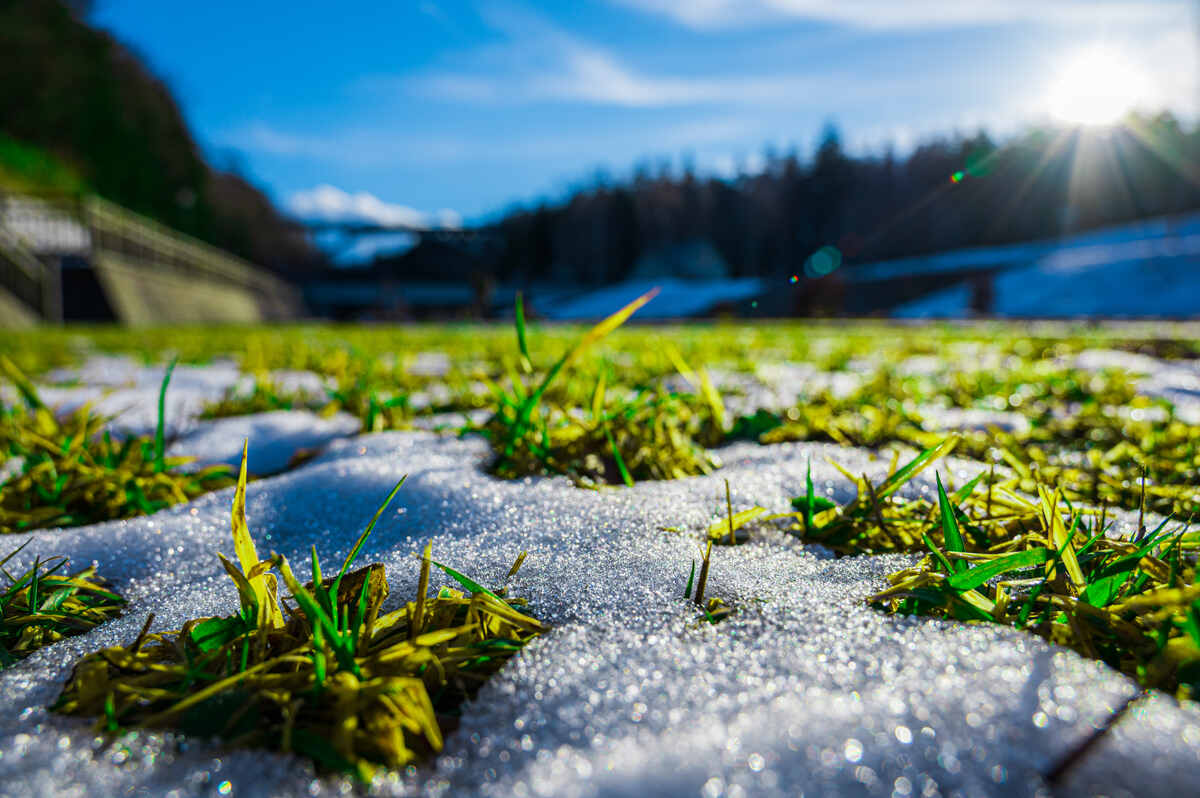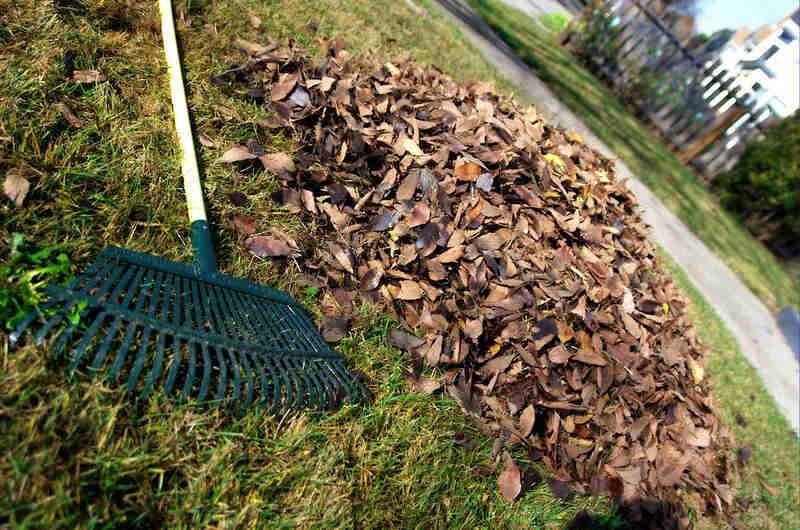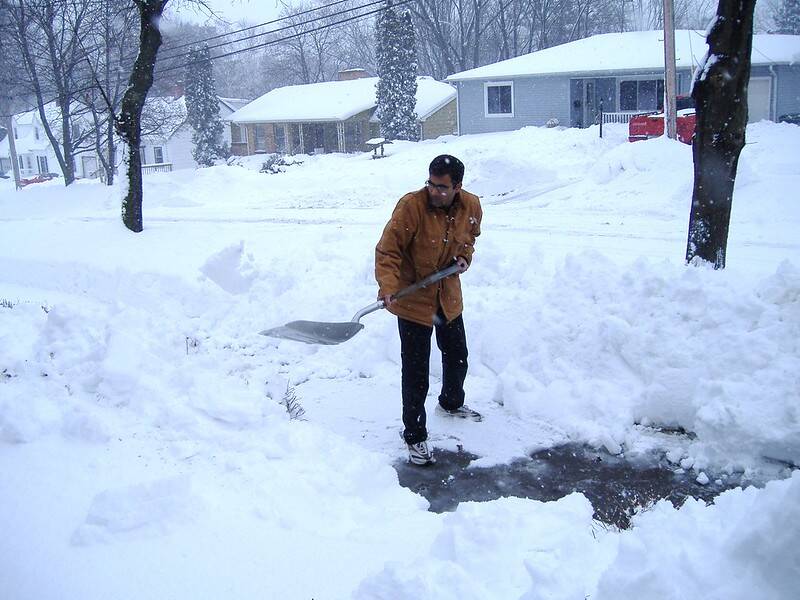
While you may think winter is a time to take a break from all lawn care, there are still some tasks you need to do to keep your grass healthy. From cleaning leaves to weeding to watering, learn how to care for your lawn in winter.
Discover what you should and shouldn’t do this winter. Keep reading to be ready to tackle the cold season like a lawn care pro.
Winter Lawn Care Tips

Keep Your Yard Clean
Winter lawn care includes cleaning up fallen leaves and debris when needed. You can use a rake or a leaf blower for it. Letting leaves cover up to 20% of your lawn is fine, but more than that, and you’re asking for trouble. Wet leaves trap moisture and can lead to diseases and pests in your lawn.
Check these articles for more information about fallen leaves:
- “What Happens If You Don’t Remove Fallen Leaves”
- “How to Rake Leaves (Step-by-Step Guide)”
- “5 Best Ways to Clean Up Leaves in Your Yard”
- “What to Do With Leaves: 7 Things”
- “How to Remove Leaves From Mulch and Flower Beds”
Dormant Seed Your Lawn
Dormant seeding is a smart strategy for getting a jump start on your lawn’s growth before spring arrives. This technique involves sowing grass seeds while the ground is too cold for immediate germination but is not yet frozen.
These seeds will remain dormant in the soil until spring. You should dormant seed in late fall to early winter when soil temperatures range between 45°F to 55°F. This method leads to quicker turfgrass establishment once the ground warms up in spring.
Continue Watering Your Lawn
In the southern parts of the country, where winters are moderate, your grass may go dormant, but could still grow slowly until the first frost or freeze.
If your area is experiencing a dry winter with about four weeks without rain, watering is necessary. It’s important to water your lawn on days when the temperature climbs above 40°F and do so before midday to allow the water to absorb before temperatures drop at night.
Control Weeds in Your Lawn
Even during the winter months, it’s important to keep an eye out for weeds. While they may not be as visible or as active as they are in the warmer months, they can still take hold and cause trouble if left unchecked.
One approach to weed control during winter is the use of a “pre-emergent” weed killer. This product prevents weed seeds from germinating, stopping weed growth before it even begins.
Pre-emergent herbicides are indeed applied during spring when the soil temperature reaches between 50 and 55°F. But you can also apply them during early winter when soil temperatures are around 70°F.
Check our articles about pre-emergent herbicides for your lawn:
What to Avoid When Caring for Your Winter Lawn

Avoid Salt for De-Icing Snow
Avoid the use of salt for snow and ice removal. De-icing products containing salt can leach into the grass, impeding nutrient uptake and creating bare spots.
If you need to treat walkways near your lawn, choose products made with sodium chloride alternatives like calcium chloride. These alternatives are less harmful to your grass while still effectively melting snow and ice.
When shoveling snow from your front sidewalks, be careful not to pile it onto your lawn. Snow removed from roads and walkways may contain residue from de-icing treatments, which can harm your grass.
Reduce Lawn Traffic
During winter, avoid heavy traffic on your lawn to maintain its health and avoid soil compaction.
When shoveling snow, be mindful of where you pile it. Avoid placing shoveled snow directly onto the lawn cause the weight of piled snow can cause compaction and bare spots. If you must pile snow on the grass, spread it out evenly to minimize the impact.
Another common cause of soil compaction is parking cars on the grass. The weight of vehicles can compress the soil. Similarly, continuous foot traffic over snowy lawns can also lead to compaction and bare patches. To prevent this, try to limit snow play and encourage walking on sidewalks instead of the lawn.
Stop Mowing
Before winter you should mow your lawn. What height you should mow? Some people say the lowest recommended height according to your type of grass while others say you should cut your grass as always.
Cool-season grasses should be mowed at the same height that has been done during summer and fall until you no longer take off grass clippings. On the other hand, with warm-season grasses, it’s best to raise the mowing height a little to help the turf tolerate winter temperatures.
But during winter, when temperatures drop below 41 degrees Fahrenheit, it’s time to stop mowing.
Here are the recommended mowing heights for cool-season grasses:
| Grass type | Ideal lawn height (Inches) |
| Tall fescue | 2 – 4 |
| Perennial ryegrass | 2- 3 |
| Kentucky bluegrass | 2 – 3 |
| Fine fescue | 1.5 – 3 |
Here are the recommended mowing heights for warm-season grasses:
| Grass type | Ideal lawn height (Inches) |
| Bahiagrass | 3 – 4 |
| Bermudagrass | 1 – 2 |
| Buffalograss | 2 – 4 |
| Carpetgrass | 1 – 2 |
| Centipedegrass | 1.5 – 2 |
| St. Augustinegrass | 2.5 – 4 |
| Zoysiagrass | 1 – 2.5 |
FAQs About Lawn Care In Winter
What should I do if my lawn dies during the winter?
If your lawn dies completely during the winter, it’s advisable to reach out to a professional lawn care service to try to recover it or start from zero.
Can I leave fallen leaves in my yard?
Yes, you can leave some leaves on your lawn, but moderation is key. Letting about 10% to 20% of the lawn covered is fine and can provide natural nutrients. However, if leaves cover more than that, they can block sunlight and trap moisture, which can suffocate the grass and lead to problems.
How much does it cost to winterize a sprinkler system?
The cost of winterizing a sprinkler system is between $60 and $120.
When to Hire a Professional
Taking care of your lawn in winter is important. By following the above tips you will set your lawn up for a healthy comeback in spring.
If you need some help or advice for winter lawn care, contact a lawn care pro.
Main Photo Credit: YUTO PHOTOGRAPHER / Adobe Stock Free / License